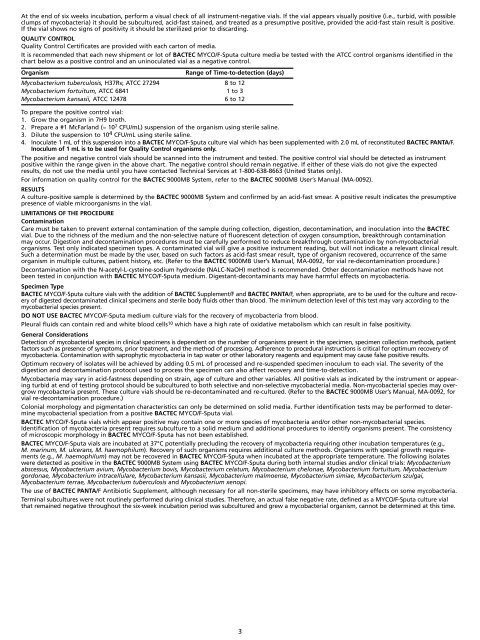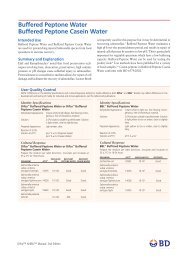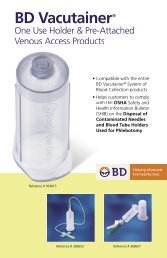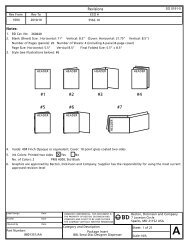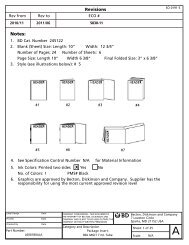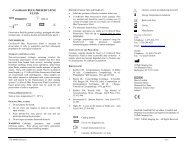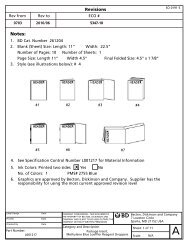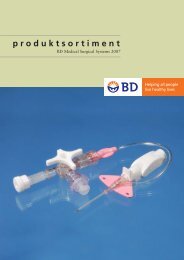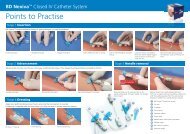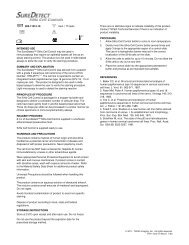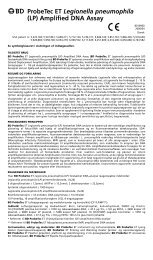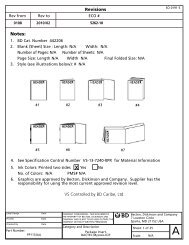BACTEC MYCO/F-Sputa Culture Vials - BD
BACTEC MYCO/F-Sputa Culture Vials - BD
BACTEC MYCO/F-Sputa Culture Vials - BD
Create successful ePaper yourself
Turn your PDF publications into a flip-book with our unique Google optimized e-Paper software.
PP101G(0604).qxd 09/09/2004 11:06 AM Page 3<br />
At the end of six weeks incubation, perform a visual check of all instrument-negative vials. If the vial appears visually positive (i.e., turbid, with possible<br />
clumps of mycobacteria) it should be subcultured, acid-fast stained, and treated as a presumptive positive, provided the acid-fast stain result is positive.<br />
If the vial shows no signs of positivity it should be sterilized prior to discarding.<br />
QUALITY CONTROL<br />
Quality Control Certificates are provided with each carton of media.<br />
It is recommended that each new shipment or lot of <strong>BACTEC</strong> <strong>MYCO</strong>/F-<strong>Sputa</strong> culture media be tested with the ATCC control organisms identified in the<br />
chart below as a positive control and an uninoculated vial as a negative control.<br />
Organism Range of Time-to-detection (days)<br />
Mycobacterium tuberculosis, H37Rv, ATCC 27294 8 to 12<br />
Mycobacterium fortuitum, ATCC 6841 1 to 3<br />
Mycobacterium kansasii, ATCC 12478 6 to 12<br />
To prepare the positive control vial:<br />
1. Grow the organism in 7H9 broth.<br />
2. Prepare a #1 McFarland (≈ 107 CFU/mL) suspension of the organism using sterile saline.<br />
3. Dilute the suspension to 104 CFU/mL using sterile saline.<br />
4. Inoculate 1 mL of this suspension into a <strong>BACTEC</strong> <strong>MYCO</strong>/F-<strong>Sputa</strong> culture vial which has been supplemented with 2.0 mL of reconstituted <strong>BACTEC</strong> PANTA/F.<br />
Inoculum of 1 mL is to be used for Quality Control organisms only.<br />
The positive and negative control vials should be scanned into the instrument and tested. The positive control vial should be detected as instrument<br />
positive within the range given in the above chart. The negative control should remain negative. If either of these vials do not give the expected<br />
results, do not use the media until you have contacted Technical Services at 1-800-638-8663 (United States only).<br />
For information on quality control for the <strong>BACTEC</strong> 9000MB System, refer to the <strong>BACTEC</strong> 9000MB User’s Manual (MA-0092).<br />
RESULTS<br />
A culture-positive sample is determined by the <strong>BACTEC</strong> 9000MB System and confirmed by an acid-fast smear. A positive result indicates the presumptive<br />
presence of viable microorganisms in the vial.<br />
LIMITATIONS OF THE PROCEDURE<br />
Contamination<br />
Care must be taken to prevent external contamination of the sample during collection, digestion, decontamination, and inoculation into the <strong>BACTEC</strong><br />
vial. Due to the richness of the medium and the non-selective nature of fluorescent detection of oxygen consumption, breakthrough contamination<br />
may occur. Digestion and decontamination procedures must be carefully performed to reduce breakthrough contamination by non-mycobacterial<br />
organisms. Test only indicated specimen types. A contaminated vial will give a positive instrument reading, but will not indicate a relevant clinical result.<br />
Such a determination must be made by the user, based on such factors as acid-fast smear result, type of organism recovered, occurrence of the same<br />
organism in multiple cultures, patient history, etc. (Refer to the <strong>BACTEC</strong> 9000MB User’s Manual, MA-0092, for vial re-decontamination procedure.)<br />
Decontamination with the N-acetyl-L-cysteine-sodium hydroxide (NALC-NaOH) method is recommended. Other decontamination methods have not<br />
been tested in conjunction with <strong>BACTEC</strong> <strong>MYCO</strong>/F-<strong>Sputa</strong> medium. Digestant-decontaminants may have harmful effects on mycobacteria.<br />
Specimen Type<br />
<strong>BACTEC</strong> <strong>MYCO</strong>/F-<strong>Sputa</strong> culture vials with the addition of <strong>BACTEC</strong> Supplement/F and <strong>BACTEC</strong> PANTA/F, when appropriate, are to be used for the culture and recovery<br />
of digested decontaminated clinical specimens and sterile body fluids other than blood. The minimum detection level of this test may vary according to the<br />
mycobacterial species present.<br />
DO NOT USE <strong>BACTEC</strong> <strong>MYCO</strong>/F-<strong>Sputa</strong> medium culture vials for the recovery of mycobacteria from blood.<br />
Pleural fluids can contain red and white blood cells10 which have a high rate of oxidative metabolism which can result in false positivity.<br />
General Considerations<br />
Detection of mycobacterial species in clinical specimens is dependent on the number of organisms present in the specimen, specimen collection methods, patient<br />
factors such as presence of symptoms, prior treatment, and the method of processing. Adherence to procedural instructions is critical for optimum recovery of<br />
mycobacteria. Contamination with saprophytic mycobacteria in tap water or other laboratory reagents and equipment may cause false positive results.<br />
Optimum recovery of isolates will be achieved by adding 0.5 mL of processed and re-suspended specimen inoculum to each vial. The severity of the<br />
digestion and decontamination protocol used to process the specimen can also affect recovery and time-to-detection.<br />
Mycobacteria may vary in acid-fastness depending on strain, age of culture and other variables. All positive vials as indicated by the instrument or appearing<br />
turbid at end of testing protocol should be subcultured to both selective and non-selective mycobacterial media. Non-mycobacterial species may overgrow<br />
mycobacteria present. These culture vials should be re-decontaminated and re-cultured. (Refer to the <strong>BACTEC</strong> 9000MB User’s Manual, MA-0092, for<br />
vial re-decontamination procedure.)<br />
Colonial morphology and pigmentation characteristics can only be determined on solid media. Further identification tests may be performed to determine<br />
mycobacterial speciation from a positive <strong>BACTEC</strong> <strong>MYCO</strong>/F-<strong>Sputa</strong> vial.<br />
<strong>BACTEC</strong> <strong>MYCO</strong>/F-<strong>Sputa</strong> vials which appear positive may contain one or more species of mycobacteria and/or other non-mycobacterial species.<br />
Identification of mycobacteria present requires subculture to a solid medium and additional procedures to identify organisms present. The consistency<br />
of microscopic morphology in <strong>BACTEC</strong> <strong>MYCO</strong>/F-<strong>Sputa</strong> has not been established.<br />
<strong>BACTEC</strong> <strong>MYCO</strong>/F-<strong>Sputa</strong> vials are incubated at 37°C potentially precluding the recovery of mycobacteria requiring other incubation temperatures (e.g.,<br />
M. marinum, M. ulcerans, M. haemophilum). Recovery of such organisms requires additional culture methods. Organisms with special growth requirements<br />
(e.g., M. haemophilum) may not be recovered in <strong>BACTEC</strong> <strong>MYCO</strong>/F-<strong>Sputa</strong> when incubated at the appropriate temperature. The following isolates<br />
were detected as positive in the <strong>BACTEC</strong> 9000MB System using <strong>BACTEC</strong> <strong>MYCO</strong>/F-<strong>Sputa</strong> during both internal studies and/or clinical trials: Mycobacterium<br />
abscessus, Mycobacterium avium, Mycobacterium bovis, Mycobacterium celatum, Mycobacterium chelonae, Mycobacterium fortuitum, Mycobacterium<br />
gordonae, Mycobacterium intracellulare, Mycobacterium kansasii, Mycobacterium malmoense, Mycobacterium simiae, Mycobacterium szulgai,<br />
Mycobacterium terrae, Mycobacterium tuberculosis and Mycobacterium xenopi.<br />
The use of <strong>BACTEC</strong> PANTA/F Antibiotic Supplement, although necessary for all non-sterile specimens, may have inhibitory effects on some mycobacteria.<br />
Terminal subcultures were not routinely performed during clinical studies. Therefore, an actual false negative rate, defined as a <strong>MYCO</strong>/F-<strong>Sputa</strong> culture vial<br />
that remained negative throughout the six-week incubation period was subcultured and grew a mycobacterial organism, cannot be determined at this time.<br />
3


